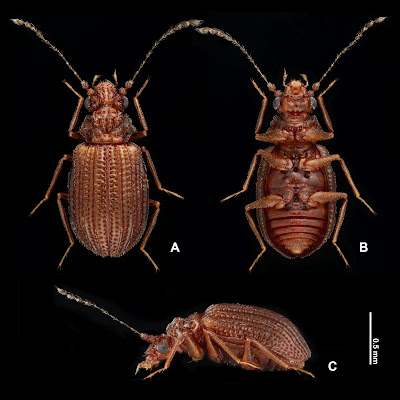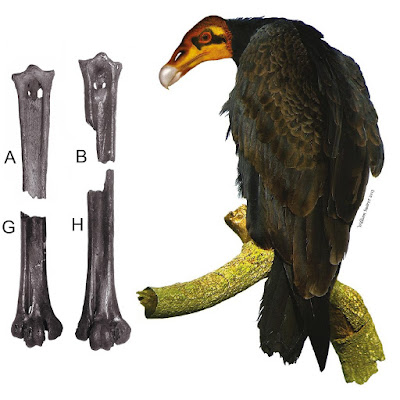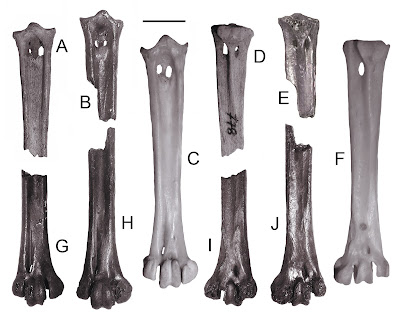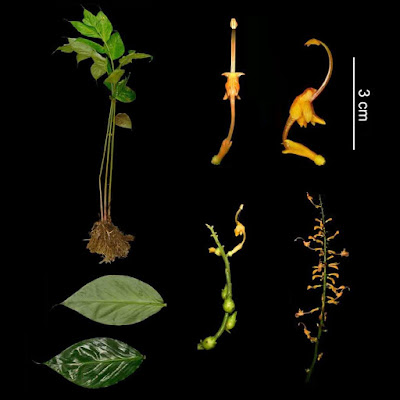[Most Recent Entries] [Calendar View]
Thursday, January 7th, 2021
| Time | Event | ||||
| 4:36a | [Entomology • 2021] Dasycerus poseidon • The First Record of the Subfamily Dasycerinae (Coleoptera: Staphylinidae) in Taiwan, with Description of A New Species
Keywords: Coleoptera, rove beetle, new species, taxonomy, mycophagy, distribution, Oriental region, barcoding, micro-CT
Fang-Shuo Hu and Wei-Ren Liang. 2021. The First Record of the Subfamily Dasycerinae in Taiwan, with Description of A New Species (Coleoptera: Staphylinidae). Zootaxa. 4903(2); 242–254. DOI: 10.11646/zootaxa.4903.2.4 | ||||
| 8:14a | [PaleoOrnithology • 2020] Cathartes emsliei • A New Fossil Vulture (Cathartidae: Cathartes) from Quaternary Asphalt and Cave Deposits in Cuba
Abstract A new small fossil species of vulture from Quaternary asphalt and cave deposits in western Cuba is described herein. Some specimens of this taxon are the smallest known in the genus Cathartes, including the modern Lesser Yellow-headed Vulture C. burrovianus. The extinction of the Cuban megafauna, coupled with the loss of open habitats once dominated by grassland savannas, contributed to the population decline and final extinction of endemic vultures in Cuba during the Holocene. Systematic paleontology Class AVES Linnaeus Order CATHARTIFORMES Coues Family CATHARTIDAE Lafresnaye
Genus Cathartes Illiger The new species agrees with the genus Cathartes and differs from Coragyps by having tarsometatarsus with short and relatively wider shaft, more compressed anteroposteriorly, anterior metatarsal groove well extended distad, and trochleae shorter and flaring abruptly from shaft. It differs from Gymnogyps Lesson, 1842, which is known from the Cuban fossil record, and agrees with Cathartes, in characters described by Emslie (1988). Cathartes emsliei sp. nov. Emslie's Vulture; Aura de Emslie ‘Cathartes? sp.': Suárez (2000a: 120). ‘referable to Cathartes': Suárez (2001: 110). ‘a small species of vulture': Suárez (2004: 124). ‘Cathartes sp.': Suárez (2020: 14). Diagnosis.—A small species of Cathartes differing from C. burrovianus by having coracoid with reduced glenoid facet, wider and deeper anterior intercondylar fossa of the tibiotarsus, and tarsometatarsus with base of throchlea II wider in posterior view. Etymology.—Named for our esteemed colleague and friend, Dr Steven D. Emslie, University of North Carolina Wilmington, USA, in recognition of his contribution to the knowledge of New World vultures, including those from Cuba. William Suárez and Storrs L. Olson. 2020. A New Fossil Vulture (Cathartidae: Cathartes) from Quaternary Asphalt and Cave Deposits in Cuba. Bulletin of the British Ornithologists’ Club. 140(3); 335-343. DOI: 10.25226/bboc.v140i3.2020.a6 | ||||
| 9:02a | [Botany • 2021] Globba ruiliensis (Zingiberaceae) • A New Species from Yunnan, China
Abstract Globba ruiliensis, a new species of Zingiberaceae from Ruili City, Yunnan Province, China, is described and illustrated. This new species is similar to G. multiflora, but clearly differs in its oblong or ovate-lanceolate leaves, 18–25 × 6–12 cm, adaxially strigose along veins, lateral staminodes are nearly equal to corolla lobes, 7–8 mm long, ovate-oblong, apex rounded, yellow to orange labellum, and verrucose ovary and fruit. A comparison table of related species is provided. Keyword: Globba multiflora, Globba sessiliflora, Globba racemosa, Haplanthera, Mantisia, Ruili Globba ruiliensis X. D. Ma, W. G. Wang & J. Y. Shen, sp. nov. 瑞麗舞花薑 Type: CHINA, Yunnan Province, Ruili City, Nongdao Town, Dengga Village, 23°57′N, 97°33′E, alt. 854 m, 21 October 2019, Jian-Yong Shen, Wen-Guang Wang & Xing-Da Ma 1666 (holotype: HITBC!; isotypes: HIB!, HITBC!, KUN!). Diagnosis: This new species is morphologically similar to G. multiflora, but clearly differs in its oblong or ovate-lanceolate leaves, 18–25 × 6–12 cm, adaxially strigose along veins (vs. oblong-lanceolate leaves, 20– 30 × 3–6 cm, adaxially glabrous), lateral staminodes are nearly equal to corolla lobes, 7–8 mm long, ovate-oblong, apex rounded (vs. lateral staminodes are smaller than corolla lobes, ca. 4 mm long, lanceolate, apex acuminate), yellow to orange labellum (vs. mostly purple labellum, only yellow towards the sinus), and verrucose ovary and fruit (vs. smooth ovary and fruit). Etymology: This new species is named for the type locality, Ruili City. Distribution and habitat: This new species is currently known from Yunnan Tongbiguan Provincial Nature Reserve, Dehong Prefecture, Yunnan Province, China, growing in wet valleys at 800–1000 m elevation. Xing-Da Ma, Wen-Guang Wang, Qiang-Bang Gong, Gui-Hua Xu, Ji-Pu Shi and Jian-Yong Shen. 2021. Globba ruiliensis, A New Species of Zingiberaceae from Yunnan, China. Taiwania. 66(1); 31-34. DOI: 10.6165/tai.2021.66.31 |
| << Previous Day |
2021/01/07 [Calendar] |
Next Day >> |









